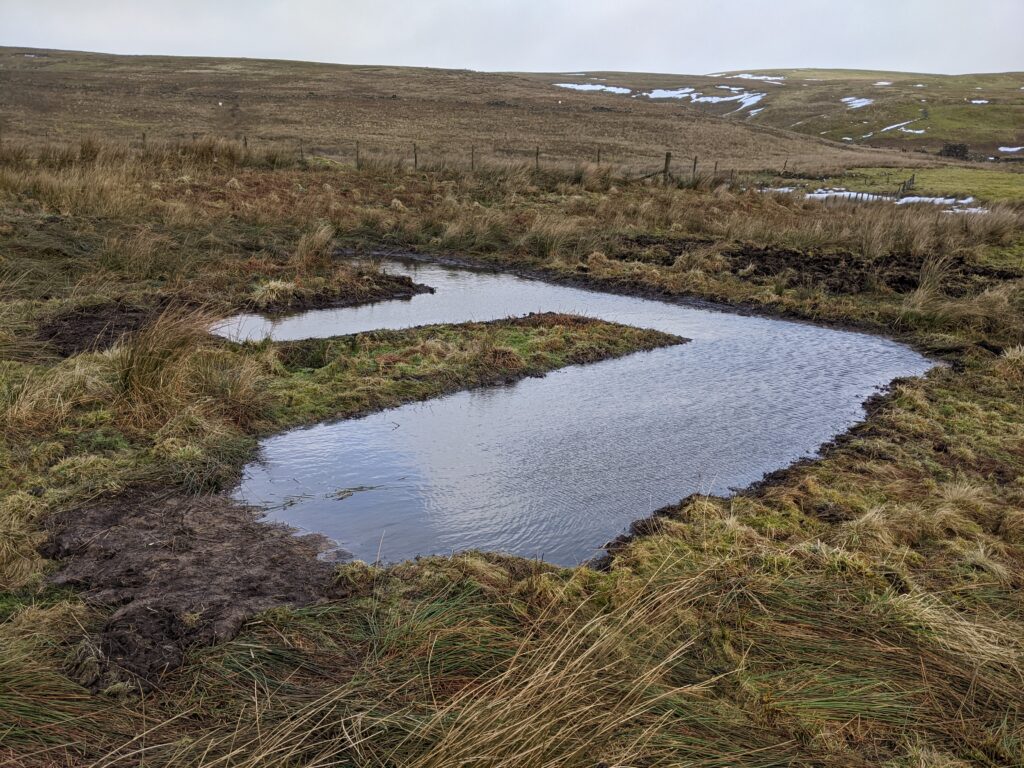News
New habitats for upland waders in the North Pennines
5 December 2024
New habitats for upland waders in the North Pennines
A nature recovery project in the North Pennines Area of Outstanding Natural Beauty is off to a flying start after new wetland habitats were created for some of the area’s iconic bird species.
The North Pennines AONB Partnership’s High Helbeck Green Recovery Challenge Fund Project is working with an upland estate to increase the biodiversity on their land. As part of this work, 15 new wader scrapes have been created, greatly enhancing the wetland habitat on site for breeding wading birds such as Curlew, Lapwing, Snipe, Oystercatcher and Redshank.
The High Helbeck project was one of the first environmental projects awarded a grant from the government’s £80 million Green Recovery Challenge Fund. The funding will enable the North Pennines AONB Partnership team and partners the RSPB and the Woodland Trust, to work with landowners Nicolete and Ben Blackett-Ord to deliver a number of improvements for nature and wildlife, The project will expand tree and scrub cover, restore peatlands and improve wildlife habitats at High Helbeck, near Brough in Cumbria.
The work on the wader scrapes was led by the RSPB. It will significantly improve breeding wader habitat at High Helbeck and from spring until the end of summer the RSPB will carry out bird surveys across the estate, including the new wetland areas. They will monitor key species and habitats to establish a baseline and to measure the impact of conservation interventions through the project.
What is a ‘scrape’?
Scrapes are shallow, invertebrate-rich pools, which are very attractive to a range of wildlife and provide very important feeding areas for breeding waders, increasing chick survival rates.
The ideal scrape should be shallow with very gently sloping edges to allow easy access for waders and their chicks. Some drying out in the summer is beneficial as this provides a muddy edge and condenses aquatic invertebrates, making them more accessible for feeding birds. A series of small scrapes is preferable to a single larger scrape as they will provide more ‘edge’ habitat for feeding, and also not concentrate all birds in one place where they may attract the attentions of predators.
Chris Jones, High Helbeck Conservation Officer for the North Pennines AONB Partnership, said: “The project only started in January and we needed to deliver this work as soon as we could to avoid disturbing the returning upland wading birds to the High Helbeck Estate.
“We’re really pleased to have completed this amount of quality wetland creation work so quickly despite the testing weather this winter. Local contractor Marsden AES Ltd completed the planned scrapes and one re-profile of an existing pond in time for the return of the waders, and we are planning more scrapes for the autumn and winter.”
Nicolete Blackett-Ord, landowner at High Helbeck has been enjoying the sights and sounds of the waders returning to the estate to breed. She said: “Some years the winter in the North Pennines seems unending and this year has had all the additional gloom of Covid, so to see and most of all to hear the returning waders lifts the heart like nothing else. Groups of lapwing have been appearing around the moor for the past few weeks and packs of Golden Plover have been grouping up by the new scrapes, but no sound of spring is as anticipated and special as the piercing song of the curlews, which starts like a yapping dog and ends in a wonderful bubbling sound quite unlike anything else and which always makes me stop and smile. Hearing the song on the moor is a return to life and just wonderful after the long winter months.”
Janet Fairclough from the RSPB said: “Creating scrapes provides a very simple way of introducing some small wetland features on fields used by breeding wading birds and other wildlife. They are especially valuable when our unpredictable British weather leads to prolonged periods with no rainfall, as it has for the past two wader breeding seasons. Scrapes are proven to significantly increase fledging success of wader chicks, by providing good quality feeding areas very close to nest sites.












